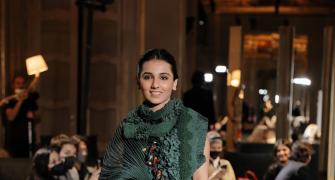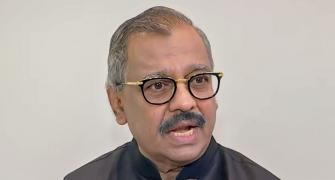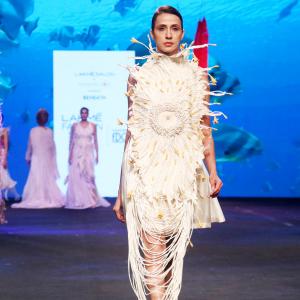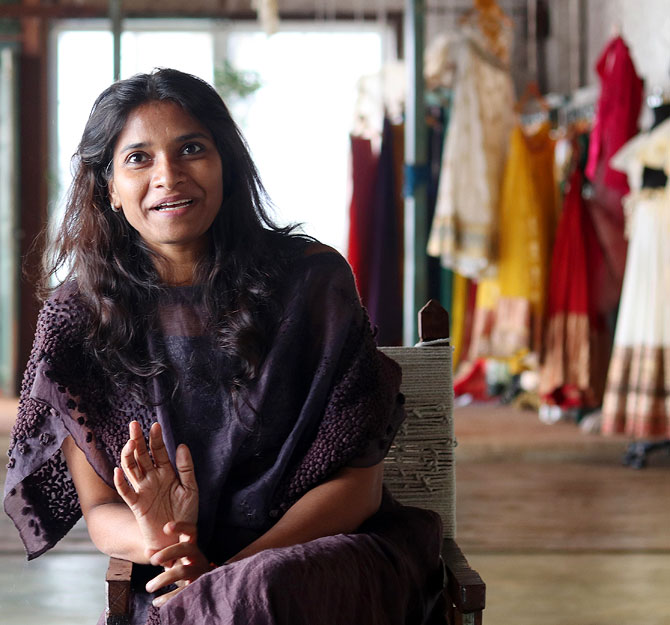There are few things that define the enigma called Vaishali S.
A petite frame that's hard to ignore, especially when she walks down the ramp beside six-foot models cheering her on.
Her signature curls with hints of caramel and chocolate that beautifully complement her dusky skin.
The spark in her eyes. The makeup free face and the smile that radiates joy 24x7.
Her designs are extraordinary, but she is rarely dresses to be noticed and doesn't care what anyone thinks.
Her dressing is her clothing, her couture, which almost always recreates 'details of textures you'll spot in nature'. The blooming of a flower. Cords mimicking the gills of a mushroom. Autumn foliage. Handweaves denoting jellyfish. Layers of the bark of a tree.
As a follower on social media would put it, 'No words and applause is good enough or justified to describe her beautiful pieces of art'.
The designer is clearly the Goliath of crossover Indian fashion, and if there's one word to describe a Vaishali S look, it would be 'green'.
Two reasons for that. First: It's her favourite colour. Second, nature serves as the ultimate inspiration for the designer, whose designs have stolen hearts across fashion capitals like Paris and Milan.
She was born in Vidhusha, Madhya Pradesh, a town next to Chanderi. As a little girl, she fell in love with chanderi, the gossamer fabric that was once a favourite among royalty, and the weave of the turbans of Maratha rulers.
"I was enchanted to see how comfortable my mother was in her chanderi saris, while at the same time always looking so beautifully elegant."
Having left her home in at the age of 17, Vaishali moved to Bhopal, took up odd jobs to survive, didn't have the money to attend a fashion school, so she taught herself to design, moved to Vadodara, began designing on a small scale, later moved to Mumbai in 1998, and in 2001, founded her label from a hole-in-the-wall boutique in north Mumbai.
Vaishali has been breathing new life into Indian handloom and 2021 saw her debut at Paris Haute Couture Week as the first Indian woman designer to ever showcase at the fashion week. She says she uses traditional Indian weaves to create a "global language" whose "soul is Indian."
Her advice for the younger generation is as powerful as her designs. "One of the most important lessons in life is to recognise that no one will give you power, and many people don't want you to have it," she tells Anita Aikara/Rediff.com. "You will have to find the courage to seize it, own it and hold on!"
Photographs and videos: Hitesh Harisinghani/Rediff.com

There is an Indianness that seeps through every look you design. How do you achieve that?
I have very strong Indian roots and I attempt to create modern silhouettes which are well-connected with nature. Whatever you see in my collections, be it the texture or the flow, it's all inspired by nature.
Nature is one, everywhere you go. I use traditional Indian weaves and try to create a global language.
The research for me as a designer is ongoing. There are so many things that I have collected in my subconscious mind which I don't even realise.
I strongly feel that one gets inspired by the past life too. You may be creating something right now, but you don't know the exact timeline of the research.
I observe so much in nature and suddenly have started using so many colours. It is stuff I have picked up unconsciously from some place I visited in the past.
Browse Vaishali's favourite pieces at her Kala Ghoda store in south Mumbai
You use such lovely shades in your collection... Fuchsia pink, forest green, ocean blue. Where do you get the inspiration to create these beautiful hues?
These colours are all in nature. I have been working with weavers in rural India and given my long association with them, they understand my mood and what I want. The connection between nature, them and me is so beautiful.
Weavers are really advanced. They don't follow any trend or colour forecast. But they create such beautiful colours because they are well-connected with nature and their surroundings.
My weavers are from different parts like Madhya Pradesh, Karnataka, West Bengal, the North East and Rajasthan.
Vaishali explains the reason why she never follows trends in the video below:
What about the fabrics that are used in your collection?
When I started, I had no knowledge of textile. It was my love for the chanderi fabric that inspired me.
I did my graduation in science. But just seeing how fabric is made was magical for me. My weavers have no knowledge of mathematics, science or geometry, but one must witness how magically they tie 10,000 threads on the loom. I learn so much from them, especially when I live with them.
I am not a trained textile designer, and my education is textile has come from these weavers. We work together, design and innovate.
Nature inspires me to create these tireless, effortless silhouettes. Everything is abundantly available in nature, and we just have to recreate it.
Be it my lines or cording, you'll notice these patterns in nature (tree trunks, waves and even inside the human body). I have done underwater training (scuba diving training) in the Maldives; it was my first experience, and got to witness beautiful corals and could pull off an entire collection on it.

The most encouraging compliment you ever received?
When I showcased in Paris during couture week, people were expecting me to show up with clothes in layers and layers of embroidery.
I went with Indian textiles and let the focus be the fabric. It was my first time there and I was very conscious. But the next day, a very important French newspaper carried my collection with the words 'Couture is back'. It was really nice to read that.
For them, couture is serious business, and it is my mission to take Indian fabric on that level always.
You steer clear from bling, intricate embroidery, lehengas, etc. Is that a conscious decision?
I have never followed trends and am not bothered by what the market demands. I just follow my intuition and imagination.
It is my passion to see beautiful weaves and fabrics shine differently. So, when I started working with weaves, I felt one doesn't need to do anything with it, because by itself, it is so beautiful.
Take a look at paithani from Maharashtra, jamdani from West Bengal, kota doria from Rajasthan -- the fabric itself is enough. One just needs to give it a good shape.
I love Indian culture and attire. Our fabrics should travel around the world.
How Vaishali's Indian roots influence her designs:
Has the Vaishali S brand shaped up the way you'd have imagined it to?
Somehow, I feel the journey has just started for me.
It is not only fashion, but more than that. For me, it is also about creating wearable art.
Do you wish there were more Indian designers on international ramps?
It's happening now. One needs to appreciate more of what we have as Indians, be proud and go all out. That's missing.
Fashion comes from the West, and whenever one thinks of it, we're reminded of the Western world.
But if you see our history, there is so much since ages. Not just our garments, our weapons, turbans and drapes were also designed beautifully.
For India, design is important. Just view our architecture. See our history.
But nowadays, everyone seems to be running a race to make money. The design and innovation are missing. Eventually I hope we get to see more Indian designers showcase their work abroad.

You travel all around India. A place which stands out for its weaves?
In Maharashtra, the paithani game is so strong. It's like a painting for me.
Khun, which earlier came from Maharashtra, has a wonderful story. I have seen my grandmother wearing khun blouses.
In temples, they offer khun weaves to the goddess. I felt this fabric has so much potential, so I found a village, which was not on the map. It took two days to reach there, and I started working with four families, which has now grown to 40 families.
I used the fabric for New York Fashion Week. It is a silk and cotton combination with beautiful designs like a sun-face, miniature elephants, etc.
Do you think the needs of artisans in India go often unheard?
We are losing artisans because these people are not getting the right money and respect. So, they'd rather work elsewhere or in factories. They want to finish their studies and take up jobs.
They need to be made aware that this is a dying art and be given their due respect. Their basic health facilities need to be taken care of. While people sell their fabrics for thousands, these artisans just make a few hundreds.
When I visited the khun village in Karnataka, they told me that if they sat at the loom, no one would give them their daughters in marriage because people don't want to be married to weavers. That narrative needs to change.
Why Vaishali can't stop talking about pashmina:
An Indian fabric you would like to revive?
I avoided pashmina for years, but I am seeing its potential now. I just keep exploring. I see fabrics and randomly travel and source it. Recently, I worked with pashmina. I never worked with it because I thought I'd hurt animals.
But I got to know that the pashmina is just combed, and no animal is hurt in the process. I travelled 6,000 metres up to the mountains, just to make sure it is true. I met the spinners and studied the overall process.
Women in the mountains do beautiful spinning. Once I was standing at a bus-stop and saw women breaking stones. I got to know they did that for the whole day and made good money. But these women don't want to spin, because the money is less.
So, I thought why not give them some spinning work and employ them, instead of breaking stones in the harsh weather?
Tips for aspiring designers?
Be open to learn and connect with yourself and nature to create something original.
Don't be inspired by Google, even though everything is readily available on it.
The minute the present generation of students graduate, they feel they are designers already. They need to have an open canvas. Also, because you are a designer doesn't mean you just need to design.
There are many processes involved in creating a garment and one should be aware of all of it.









